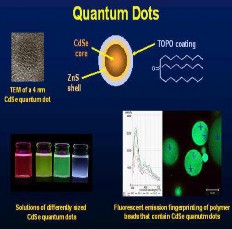68. QUANTUM DOT-
♤ Quantum dots are tiny particles, or “nanoparticles”, of a semiconductor material, traditionally chalcogenides (selenides or sulfides) of metals like cadmium or zinc (CdSe or ZnS, for example), which range from 2 to 10 nanometers in diameter (about the width of 50 atoms).

♤ Because of their small size, quantum dots display unique optical and electrical properties that are different in character to those of the corresponding bulk material. The most immediately apparent of these is the emission of photons under excitation, which are visible to the human eye as light. Moreover, the wavelength of these photon emissions depends not on the material from which the quantum dot is made, but its size.
♤ The ability to precisely control the size of a quantum dot enables the manufacturer to determine the wavelength of the emission, which in turn determines the colour of light the human eye perceives. Quantum dots can therefore be “tuned” during production to emit any colour of light desired. The ability to control, or “tune” the emission from the quantum dot by changing its core size is called the “size quantisation effect”.

♤ The smaller the dot, the closer it is to the blue end of the spectrum, and the larger the dot, the closer to the red end. Dots can even be tuned beyond visible light, into the infra-red or into the ultra-violet.



♤ Quantum dots are particularly significant for optical applications due to their high extinction co- efficient.In electronic applications they have been proven to operate like a single electron transistor and show the Coulomb blockade effect. Quantum dots have also been suggested as implementations of qubits for quantum information processing.
♤ The ability to tune the size of quantum dots is advantageous for many applications. For instance, larger quantum dots have a greater spectrum-shift towards red compared to smaller dots, and exhibit less pronounced quantum properties. Conversely, the smaller particles allow one to take advantage of more subtle quantum effects.
